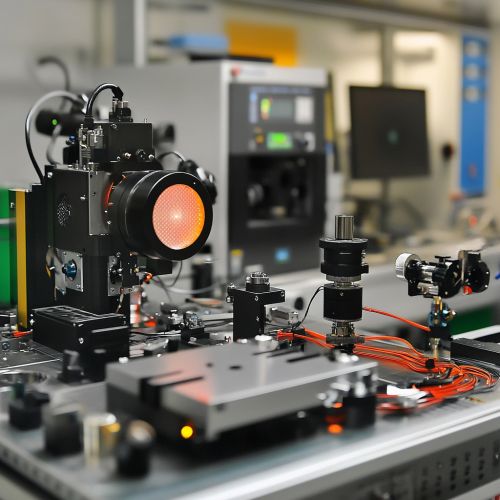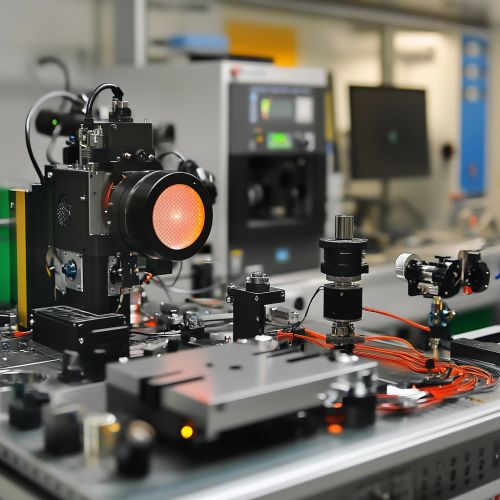Parametric oscillation: Difference between revisions
(Created page with "== Introduction == Parametric oscillation is a phenomenon in which the parameters of a system, such as its natural frequency, are varied periodically over time, leading to oscillations. This concept is prevalent in various fields of physics and engineering, including optics, electronics, and mechanical systems. The study of parametric oscillation involves understanding the conditions under which these oscillations occur, their stability, and their applications. == Theor...") |
No edit summary |
||
| Line 21: | Line 21: | ||
An optical parametric oscillator is a device that converts a pump laser beam into two different wavelengths, known as the signal and idler waves, through the process of [[parametric down-conversion]]. OPOs are widely used in spectroscopy, telecommunications, and quantum optics due to their ability to generate coherent light over a broad range of wavelengths. | An optical parametric oscillator is a device that converts a pump laser beam into two different wavelengths, known as the signal and idler waves, through the process of [[parametric down-conversion]]. OPOs are widely used in spectroscopy, telecommunications, and quantum optics due to their ability to generate coherent light over a broad range of wavelengths. | ||
[[Image:Detail-97625.jpg|thumb|center|An optical parametric oscillator setup in a laboratory, showing the laser source and optical components.|class=only_on_mobile]] | |||
[[Image:Detail-97626.jpg|thumb|center|An optical parametric oscillator setup in a laboratory, showing the laser source and optical components.|class=only_on_desktop]] | |||
=== Mechanical Systems === | === Mechanical Systems === | ||
Latest revision as of 09:32, 16 August 2024
Introduction
Parametric oscillation is a phenomenon in which the parameters of a system, such as its natural frequency, are varied periodically over time, leading to oscillations. This concept is prevalent in various fields of physics and engineering, including optics, electronics, and mechanical systems. The study of parametric oscillation involves understanding the conditions under which these oscillations occur, their stability, and their applications.
Theory of Parametric Oscillation
Parametric oscillation can be understood through the lens of differential equations and nonlinear dynamics. The fundamental equation governing parametric oscillation is the Mathieu equation, which is a type of linear differential equation with periodic coefficients. The general form of the Mathieu equation is:
\[ \frac{d^2x}{dt^2} + (a - 2q \cos(2\omega t))x = 0 \]
where \(a\) and \(q\) are parameters, and \(\omega\) is the angular frequency of the periodic modulation.
Stability Analysis
The stability of solutions to the Mathieu equation is determined by the values of \(a\) and \(q\). Stability charts, known as Mathieu stability charts, are used to visualize the regions of stability and instability in the parameter space. These charts are essential for predicting the behavior of parametric oscillators and designing systems that exploit or avoid parametric resonance.
Parametric Resonance
Parametric resonance occurs when the frequency of the parameter variation is close to twice the natural frequency of the system. This condition leads to a significant increase in the amplitude of oscillations. Parametric resonance is a critical concept in the design of parametric amplifiers and other devices that rely on controlled oscillations.
Applications of Parametric Oscillation
Parametric oscillation has a wide range of applications across different scientific and engineering disciplines.
Optical Parametric Oscillators (OPOs)
An optical parametric oscillator is a device that converts a pump laser beam into two different wavelengths, known as the signal and idler waves, through the process of parametric down-conversion. OPOs are widely used in spectroscopy, telecommunications, and quantum optics due to their ability to generate coherent light over a broad range of wavelengths.


Mechanical Systems
In mechanical systems, parametric oscillation can be observed in structures subjected to periodic loading. For example, the parametric excitation of a pendulum can lead to large amplitude oscillations if the length of the pendulum is varied periodically. This principle is used in certain types of vibration absorbers and energy harvesting devices.
Electronic Parametric Amplifiers
Parametric amplifiers in electronics exploit the principle of parametric oscillation to amplify weak signals. These amplifiers use a nonlinear reactive element, such as a varactor diode, whose capacitance varies periodically with an external signal. This variation modulates the input signal and produces an amplified output.
Mathematical Formulation
The mathematical formulation of parametric oscillation involves solving the Mathieu equation and analyzing its solutions. The solutions can be expressed in terms of Mathieu functions, which are special functions that describe the behavior of the system under periodic modulation.
Floquet Theory
Floquet theory is a powerful tool used to analyze the stability of periodic solutions to differential equations. According to Floquet theory, the solutions to the Mathieu equation can be expressed as a product of a periodic function and an exponential function. This representation helps in understanding the growth or decay of oscillations over time.
Bifurcation Analysis
Bifurcation analysis is used to study the changes in the qualitative behavior of a system as parameters are varied. In the context of parametric oscillation, bifurcation analysis helps in identifying the critical points where the system transitions from stable to unstable behavior or vice versa.
Experimental Observations
Experimental studies of parametric oscillation involve setting up systems with controllable parameters and measuring their response to periodic modulation. High-precision instruments, such as laser interferometers and oscilloscopes, are used to capture the oscillatory behavior and validate theoretical predictions.
Case Studies
Several case studies highlight the practical applications and challenges of parametric oscillation. For instance, the use of parametric oscillators in gravitational wave detectors has been extensively studied to enhance the sensitivity of these instruments. Another example is the development of parametric amplifiers for low-noise communication systems.
Challenges and Future Directions
Despite the extensive research on parametric oscillation, several challenges remain. One of the primary challenges is the precise control of parameters to achieve desired oscillatory behavior. Additionally, the effects of noise and non-idealities in real-world systems need to be thoroughly understood and mitigated.
Future research directions include the development of advanced materials and devices that can exploit parametric oscillation more efficiently. The integration of parametric oscillators with quantum technologies is another promising area, with potential applications in quantum computing and secure communication.
Conclusion
Parametric oscillation is a fundamental phenomenon with diverse applications in science and engineering. Understanding the theoretical underpinnings, stability conditions, and practical implementations of parametric oscillators is crucial for advancing technology in various fields. Continued research and innovation in this area hold the promise of new and exciting developments.
